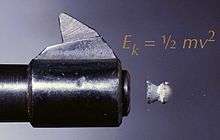Muzzle energy
Muzzle energy is the kinetic energy of a bullet as it is expelled from the muzzle of a firearm. Without consideration of factors such as aerodynamics and gravity for the sake of comparison, muzzle energy is used as a rough indication of the destructive potential of a given firearm or cartridge. The heavier the bullet and especially the faster it moves, the higher its muzzle energy and the more damage it will do.

Kinetic energy
The general formula for the kinetic energy is
where
Although both mass and velocity contribute to the muzzle energy, the muzzle energy is proportional to the mass while proportional to the square of the velocity. The velocity of the bullet is a more important determinant of muzzle energy. For a constant velocity, if the mass is doubled, the energy is doubled; however, for a constant mass, if the velocity is doubled, the muzzle energy increases four times. In the SI system the above Ek will be in unit joule if the mass, m, is in kilogram, and the speed, v, is in metre per second.[1]
Typical muzzle energies of common firearms and cartridges
Muzzle energy is dependent upon the factors previously listed, and velocity is highly variable depending upon the length of the barrel a projectile is fired from.[2] Also the muzzle energy is only an upper limit for how much energy is transmitted to the target, and the effects of a ballistic trauma depend on several other factors as well. While the above list mentions some averages, there is wide variation in commercial ammunition. A 180-grain (12 g) bullet fired from .357 magnum handgun can achieve a muzzle energy of 580 foot-pounds force (790 J). A 110-grain (7.1 g) bullet fired from the same gun might only achieve 400 foot-pounds force (540 J) of muzzle energy, depending upon the manufacture of the cartridge. Some .45 Colt ammunition can produce 1,200 foot-pounds force (1,600 J) of muzzle energy, far in excess of the average listed above.
Legal requirements on muzzle energy
Some jurisdictions stipulate minimum muzzle energies for hunting. For example, in Denmark rifle ammunition used for hunting the largest types of game there such as red deer must have a kinetic energy E100 (i.e.: at 100m range) of at least 2700 J and a bullet mass of at least 9 g or alternatively an E100 of at least 2000 J and a bullet mass of at least 10 g.[3] Namibia specifies three levels of minimum muzzle energy for hunting, 1350 J for game such as springbok, 2700 J for game such as hartebeest and 5400 J for big game, together with a minimum caliber of 7 mm.[4]
In Germany airsoft guns with a muzzle energy of no more than 0.5 J are exempt from the gun law,[5] while air guns with a muzzle energy of no more than 7.5 J may be acquired without a firearms license.[6]
Mainland China uses a concept of "muzzle ratio kinetic energy" (Chinese: 枪口比动能), which is the quotient (ratio) of the muzzle energy divided by the bore cross sectional area, to distinguish genuine guns from "imitation" replicas like toy guns. The Ministry of Public Security unilaterally introduced the concept in 2008 leading up to the Beijing Olympic Games, dictating that anything over 1.8 J/cm2 to be defined as real firearms. This caused many existing toy gun products on the Chinese market (particularly airsoft) to become illegal overnight, as almost all airsoft guns shooting a standard 0.20 gram 6mm pellet have a muzzle velocity over 250 ft/s (76 m/s), which translates to more than 0.58 J (0.43 ft⋅lbf) of muzzle energy, or 2.0536 J/cm2 of "ratio energy". The subsequent heavy-handed crackdowns by local law enforcement led to many seizures, arrests and prosecutions of individual owners for "trafficking and possession of illegal weapons" over the years.
Resources
- Edward F. Obert, Thermodynamics, McGraw-Hill Book Co., 1948.
- Mc Graw-Hill encyclopedia of Science and Technology, volume ebe-eye and ice-lev, 9th Edition, Mc Graw-Hill, 2002.
References
- Beer, Ferdinand P.; Johnston, E. Russell, Jr; Cornwell, Phillip J. (2013). Vector Mechanics for Engineers (10th ed.). New York, NY: McGraw-Hill. p. 768. ISBN 978-0-07-740232-7.
- "BBTI - Ballistics by the Inch - Home". ballisticsbytheinch.com.
- "Bekendtgørelse om skydevåben og ammunition, der må anvendes til jagt m.v." [Hunting weapons and ammunition act]. retsinformation.dk (in Danish). Miljøministeriet. 2012-12-17. Ammunition. Retrieved 2015-03-10.
- "NAPHA - Namibia Professional Hunting Assiation: Hunting Laws& Rifle Importation". napha-namibia.com. Retrieved 5 July 2015.
- "Ab welcher Geschossenergie fallen Soft-Air-Waffen unter das Waffengesetz?" [From which muzzle energy does Airsoft guns fall under the gun law?]. www.bmi.bund.de (in German). Archived from the original on 2016-03-04. Retrieved 2015-09-17.
- "Waffengesetz (WaffG)" [gun law]. gesetze-im-internet.de (in German). Retrieved 2015-09-19.